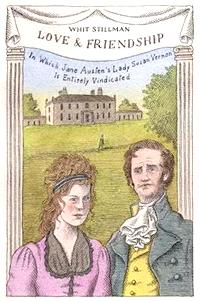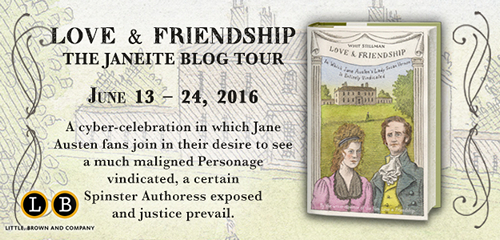From the desk of Tracy Hickman: Lady Susan is my favorite of Jane Austen’s minor works. A scheming widow who also happens to be “the most accomplished coquette in England,” Lady Susan Vernon is intelligent, attractive, and unscrupulous, agreeing with her immoral friend Alicia Johnson that “Facts are such horrid things!” (256) Her letters to... Continue Reading →
Q&A with Love & Friendship Writer/Director/Author Whit Stillman
Austen scholar Devoney Looser joins us today during the Love & Friendship Janeite Blog Tour to interview ‘Friend of Jane,’ writer/director/author Whit Stillman, whose new hit movie Love & Friendship, and its companion novel, are on the radar of every Janeite. Welcome, Ms. Looser and Mr. Stillman to Austenprose.com. Devoney Looser: We Janeites know that... Continue Reading →
A Preview of Love & Friendship: In Which Jane Austen’s Lady Susan Vernon Is Entirely Vindicated, by Whit Stillman
Writer, director, and friend of Jane Austen, Stillman has written a companion novel to the film also entitled Love & Friendship with the added subtitle: In Which Jane Austen’s Lady Susan Vernon Is Entirely Vindicated. For those who have read Austen’s original novella, you will remember that Lady Susan Vernon is described by Reginald De... Continue Reading →
Lady Vernon and Her Daughter, by Jane Rubino & Caitlen Rubino-Bradway – A Review
After being introduced to Jane Austen’s Lady Susan via A Soiree for Lady Susan, Austenprose’s rollicking cyber group read, replete with wagging tongues and fluttering fans, I delighted in discovering this ‘most accomplished Coquette in England’. So different from other Austen heroines, I welcomed her all the more for her flagrant flaws and mercenary machinations. Regretfully, as Jane Austen never got the chance to revise this novella, the limitations of the epistolary form did leave me with a desire for more. Enter Jane Rubino and Caitlen Rubino-Bradway’s novel Lady Vernon and Her Daughter, which certainly fulfills this desire… and more! This clever re-imagining by a mother and daughter team turns my previous notion about this heroine on its head. It intriguingly opens with an Austen inspired witticism:
A Preview of Lady Vernon and her Daughter & Guest Blog with Authors Jane Rubino & Caitlen Rubino-Bradway
There are some great writers who wrote too much. There are others who wrote enough. There are yet others who wrote nothing like enough to satisfy their admirers, and Jane Austen is certainly one of these. Margaret Drabble I love this quote by Austen scholar Margaret Drabble. It is the opening line of her introduction... Continue Reading →
Announcing – Lady Vernon and her Daughter Book Trailer
Austenprose is very honored to have the privilege of announcing the exclusive premiere of the Lady Vernon and her Daughter: A Novel of Jane Austen's Lady Susan book trailer. This new retelling of Jane Austen's novella Lady Susan was co-written by mother and daughter team Jane Rubino and Caitlen Rubino-Bradway and is due out on October 6th, 2009.... Continue Reading →




